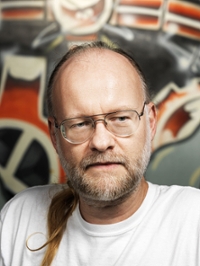Recent News
UNM Engineering names Prabhakar inaugural Cleve Moler and MathWorks Endowed Chair
October 3, 2025
Computer scientist wins Athlete of the Year Award for adaptive skiing technique
May 29, 2025
Hand and Machine Lab wins 2 awards at CHI conference
May 15, 2025
News Archives
UNM Grad Featured in Wired Magazine
May 15, 2015
Cow Milk Without the Cow Is Coming to Change Food Forever
by Marcus Wohlsen
COUNTER CULTURE LABS takes its name pretty literally. It is a bio lab, for sure, complete with pipettes, carboys, microscopes, and flasks. But it is decidedly counter to the traditional culture of laboratory science. The DIY tinkerers who hang out here—in the back of a sprawling space that used to house a heavy metal club in Oakland, California—are working beyond conventional notions of inquiry and research. Their goal is nothing less than to hack nature.
Consider one group of bio-hackers who meet in the lab each Monday night to work on a project that sounds like a contradiction in terms: They’re trying to make cow’s milk cheese without the cow. Using mail-order DNA, they’re tricking yeast cells into producing a substance that’s molecularly identical to milk. And if successful, they’ll turn this milk into cheese. Real cheese. But vegan cheese. Real vegan cheese.
That’s the name of the project: Real Vegan Cheese. These hackers want cheese that tastes like the real thing, but they don’t want it coming from an animal. Abandoning real cheese is one of the hardest sacrifices vegans must make, says one member of the group, Benjamin Rupert, a chemist by training and a vegan for the past decade. With Real Vegan Cheese, they won’t have to. “What we’re making is identical to the animal protein,” he says. “You’re not giving anything up, really.”
This may sound strange, silly, and more than a little far-fetched. But it’s real. We’ve reached the point where hacking DNA is neither technically difficult nor terribly expensive. Sequencing a human genome used to cost billions of dollars. Now, it costs a few thousand. The same Moore’s law-type effect has dramatically cut the cost of “writing” genes. Ordering snippets of custom DNA with letter-by-letter precision is as simple as filling out an online form, and the cost is less than 25 cents per base pair—a price that puts the genes for making quasi-cow’s milk within reach of hobbyists.
However odd this project may seem, it shows what soon will be possible with homegrown food science. We’re approaching a world where the divide between the “natural” and the “artificial” collapses, where amateurs in their kitchens can fiddle with life to make edible substances that are both artisanal and the most radically processed foods ever made.
Natural Curiosity
 |
| Patrick D'haeseleer, a Harvard-trained computational biologist and biotech cheesemaker. |
Counter Culture Labs, in keeping with its DIY spirit, is itself a work-in-progress, a space for tinkering that’s constantly being tinkered with.
When I visited late last year, one half-built lab bench included a pig’s heart floating in a glass jar. It was pale white but for a metal pipe jutting from the top, the heart chemically stripped of all but its cartilage. If this were a movie, a ghost heart would be an ominous sign that here was a place where science had gone awry, where nature is being perverted. But the vibe at Counter Culture Labs is more science-fair than mad-scientist.
The heart belongs to Patrik D’haeseleer, a Harvard-trained computational biologist who leads a research group at Lawrence Livermore National Lab. He said the ghost heart could be used as a scaffold on which living tissue could be grown to create transplantable organs from a patient’s own cells. Counter Culture Labs, he says, lets him explore such things in a hands-on way that isn’t possible with his day job.
His attitude exemplifies what’s called the DIY biotech movement, which has emerged in the past decade. The movement’s goal, as Counter Culture Labs’ website succinctly notes, is to “excite curiosity and empower exploration … We offer a comfy, open space in which to learn, create, tinker and innovate. Open to citizen scientists, biohackers, and empiricists of all stripes!” The movement self-consciously compares itself to the homebrew digital pioneers of the 1970s, who wrested digital technology out of academia and business and into the wider realm of the amatuers. It’s open to anyone with an idea.
An idea like Real Vegan Cheese.
When I visit the lab, I discover the cheese team includes a biologist, a bioethicist, a retired clinical psychologist, an accountant, and a former Apple marketer. “This to me is a natural extension of computer culture,” says Maria Chavez, the ex-Apple employee and a leader of the vegan cheese project. “What is bigger to hack than our bodies and our environment? It’s one of the last big frontiers. The possibilities are exciting.”
The possibilities include not just vegan cow cheese, but, well, vegan human cheese. The same basic process for synthesizing cow’s milk applies to milk from any other mammal. You just need different genes. Cheese made from engineered human breast milk may not sound like a top seller at the deli counter. But the team says it can serve a practical purpose: Human milk cheese could offer an option to people who have allergies to non-human dairy products. (Chavez said the group has put its experiments with human milk on hold due to Food and Drug Administration concerns about possible autoimmune reactions.)
They also hope to engineer cheese based on the milk of the narwhal, the most outlandish mammal they could imagine. They hear the milk has the consistency of toothpaste.
Full Article
